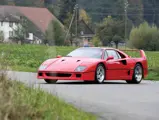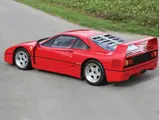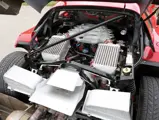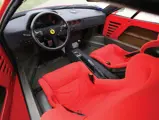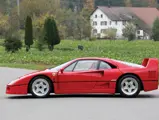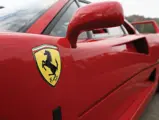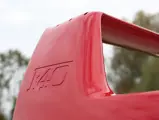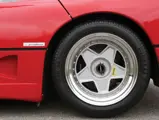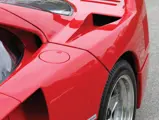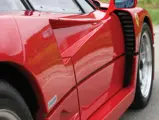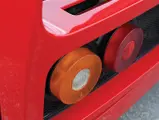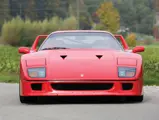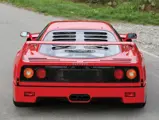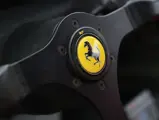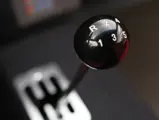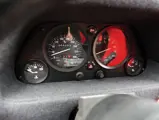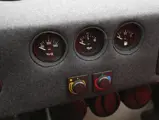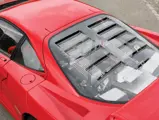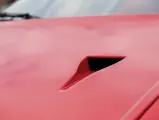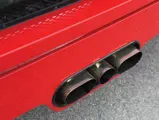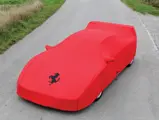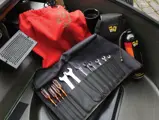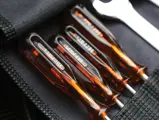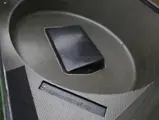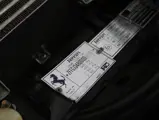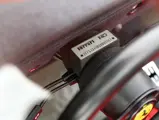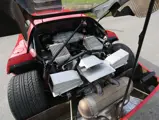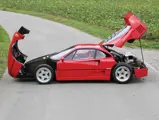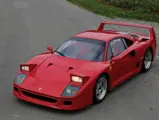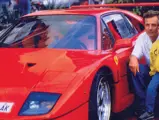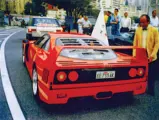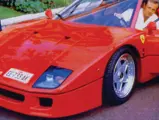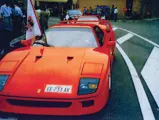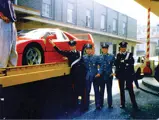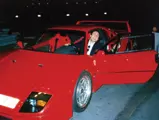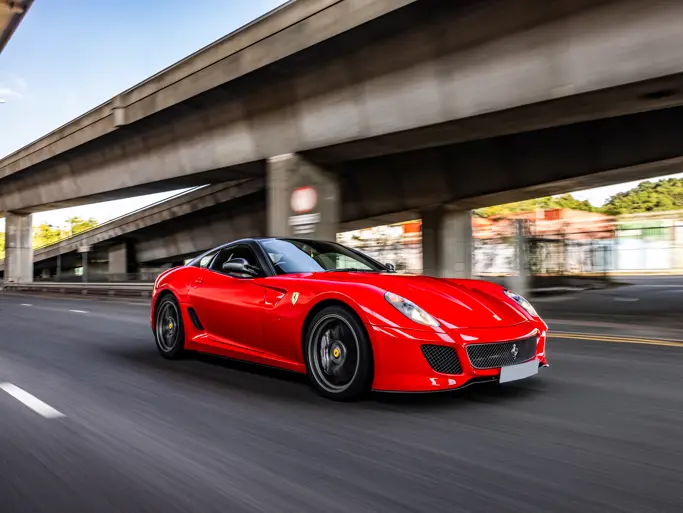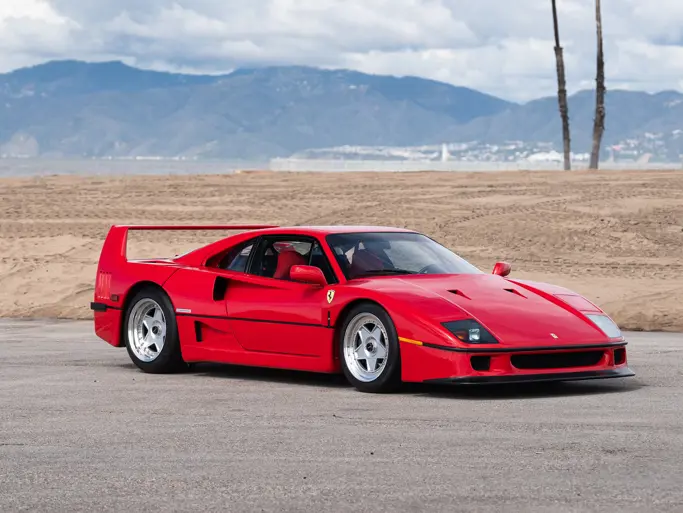Paris 2016
1989 Ferrari F40
{{lr.item.text}}
€1,036,000 EUR | Sold
 | Paris, France
| Paris, France
{{internetCurrentBid}}
{{internetTimeLeft}}

- Delivered new to Stefano Casiraghi in Monaco
- Fitted with desirable Plexiglas windows
- Just over 4,000 kilometres from new and recently serviced
- Complete with original tools and books
- Single private ownership for the last 26 years
- Livrée neuve à Stefano Casiraghi, à Monaco
- Un des premiers exemplaires, avec vitres coulissantes en plexiglas
- seulement 4 000 km depuis l'origine, révision récente
- Complète avec outils et manuels d'usine
- Un seul propriétaire depuis 26 ans
478 bhp, 2,936 cc DOHC 90-degree V-8 engine with two turbochargers and Weber-Marelli engine management and fuel injection, five-speed manual gearbox, tubular steel and carbon-composite chassis, independent double-wishbone suspension with Koni hydraulic shock absorbers and front and rear anti-roll bars, and four-wheel ventilated disc brakes. Wheelbase: 2,450 mm
V8 à 90°, 2 936 cm3, 2 ACT par banc, 478 ch, 2 turbos, injection et gestion moteur Weber-Marelli, transmission manuelle cinq rapports, châssis tubulaire acier et carbone, suspension indépendante par doubles triangles, amortisseurs hydrauliques Koni, barre antiroulis avant/arrière, freins à disques ventilés sur les quatre roues. Empattement 2 450 mm.
The year 1987 was big for Enzo Ferrari. Not only did he celebrate his 90th birthday, but, more importantly to him, it was also 40 years since he built his first car. A year earlier, Enzo was reported to have said, “Let’s make something special for next year’s celebrations, in the way we used to do it”.
The name for this new car had been suggested by a friend of Ferrari’s, Gino Rancati, who was at Ferrari’s office for a meeting with Razelli, the general manager. Razelli had shown him the new Ferrari, which was to be unveiled at the Frankfurt Motor Show. Rancati asked what it would be called, and Razelli replied that they had two or three possible names but wondered what he would call it. Rancati replied, “Since Ferrari’s biggest market is the United States, and since it is now 40 years since the first Ferrari car has appeared, it should have an English-language name, for example ‘Ferrari Forty’”.
Mechanically, the F40 bore much in common with the 288 GTO, and it was, in fact, closely based on the GTO Evoluzione, the race version of the GTO. The F40’s engine was also based on the twin-turbocharged V-8, which was bored to displace almost three litres. The car’s output exceeded 478 horsepower, making the F40 Ferrari’s most powerful road car to date. Ferrari’s riposte to the Lamborghini Countach and the Porsche 959 was to create the first production car to break the mythical 200-mph barrier, and the F40 did just that, as it was capable of reaching a top speed of 201.4 mph.
THE ROYAL CONNECTION
Fittingly for what was the world’s fastest car, those with the means and appetite for such a car were often large personalities with a daredevil attitude. Few people sum up this description better than Stefano Casiraghi, to whom this F40, with its desirable Plexiglas windows, was delivered in March 1989. Casiraghi was an Italian socialite and businessman who would go on to become the second husband of Princess Caroline of Monaco. He was photographed many times in this car with Princess Caroline, as the couple made the most of the Monaco nightlife.
A true daredevil, Casiraghi participated in 80 offshore powerboat races during his lifetime. Over a 20-year career, he won a dozen competitions and was the offshore speedboat world champion at the time of his shocking death in a race off the coast of Monaco. During his time with this F40, Casiraghi was often photographed in it, most notably when he led the Speedboat Parade around the streets of Monaco (images of which, as well as several publications covering the event, are included on file). In May 1989, the F40 was sold to the current owner at the request of the Princess of Monaco. As Stefano had a reputation for spirited driving, the Princess was apparently scared of the car. A copy of the sales invoice with Casiraghi’s signature on it is also noted on file.
Well cared for over its life, this F40 has been driven sparingly, amassing just over 4,000 kilometres from new. In fact, it has travelled just over 600 kilometres in the past eight years. The F40 has benefitted from a recent service at Rolf Plus Renn-und Sportcars in Switzerland and is presented in original condition with factory tools and books.
The Ferrari F40 was the last Maranello road car to be engineered under Enzo Ferrari’s direct leadership and remains one of the most celebrated high-performance supercars ever built. This example, with its desirable configuration, its royal connection, and the fact it was owned by a true daredevil, is surely one of the best.
L'année 1987 est importante pour Enzo Ferrari. Non seulement il célèbre son 90e anniversaire, mais en plus il s'est écoulé 40 ans depuis la fabrication de sa première voiture. L'année précédente, Enzo aurait affirmé : "Préparons quelque chose de spécial pour les célébrations de l'année prochaine, comme nous avions coutume de le faire."
Le nom de ce nouveau modèle a été suggéré par un ami de Ferrari, Gino Rancati, lors d'une réunion chez Ferrari avec Razelli, directeur général. Razelli lui a montré la nouvelle Ferrari, qui devait être dévoilée au Salon de Francfort. Rancati a demandé comment elle allait s'appeler, et Razelli lui a répondu qu'il existait deux ou trois possibilités, tout en sollicitant son propre avis. Rancati a répondu : "Pour Ferrari le marché, le plus important sont les États-Unis, et c'est il y a quarante ans qu'est sortie la première Ferrari, donc il faudrait choisir un nom à consonance anglaise, comme par exemple "Ferrari Forty"."
Mécaniquement, la F40 partageait beaucoup avec la 288 GTO ; elle était en fait étroitement dérivée de la GTO Evoluzione, sa version compétition. Le moteur de la F40 était basé sur le V8 à deux turbocompresseurs, réalésé à presque 3 litres. Les modifications permettaient une augmentation de puissance, qui dépassait 478 ch, ce qui faisait de la F40 la voiture de route la plus puissante de son époque. La réponse de Ferrari à la Lamborghini Countach et à la Porsche 959 était de produire la première voiture de série capable de franchir la barre symbolique de 200 mph (321 km/h). Par conséquent, la F40 atteignait 201,4 mph (324 km/h) en pointe.
La connexion Princère
Il était logique, s'agissant de la voiture la plus rapide du monde, que ceux qui avaient les moyens et le goût pour une telle machine soient des personnalités expansives, affichant une attitude intrépide. Rares sont ceux qui répondent aussi bien à cette définition que Stefano Casiraghi, à qui était livrée en mars 1989 cette F40, dotée de ses désirables vitres coulissantes en Plexiglas. Casiraghi était un homme d'affaires et une personnalité mondaine qui allait devenir le deuxième mari de la princesse Caroline de Monaco. Il avait été photographié de nombreuses fois en compagnie de la princesse Caroline, avec qui il sortait souvent le soir à Monaco.
Pilote hardi, Casiraghi avait pris le départ de plus de 80 compétitions à bord de bateaux de course offshore. Au cours d'une carrière de plus de 20 ans, il avait remporté une douzaine d'épreuves et il était même, au moment de l'accident qui lui a coûté la vie au large de Monaco, Champion du monde en titre de cette spécialité. A l'époque où il possédait la Ferrari F40, il était souvent photographié au volant, en particulier en ouvrant la "Speedboat Parade" dans les rues de Monaco (dont des photos et articles sont inclus dans le dossier). En mai 1989, la F40 était vendue à son actuel propriétaire, à la demande de la princesse de Monaco. Stefano avait la réputation de conduire vite, et cette voiture effrayait semble-t-il la princesse. Une copie de la facture de vente, portant la signature de Casiraghi, fait partie du dossier.
Très bien entretenue, cette F40 a été utilisée avec parcimonie, ne couvrant qu'à peine plus de 4 000 km depuis l'origine. En fait, elle n'a parcouru que 600 km au cours des huit dernières années. Elle a bénéficié d'une révision récente effectuée par Rolf Plus Renn- und Sportcars, en Suisse, et se présente en état d'origine, avec outils et manuels d'usine.
La Ferrari F40 est la dernière voiture de Maranello conçue sous l'autorité directe d'Enzo Ferrari et elle reste une des supercars les plus célèbres jamais produites. Cet exemplaire, avec sa configuration désirable, sa connexion monégasque et le fait qu'elle a appartenu à un pilote audacieux, est certainement un des meilleurs.

